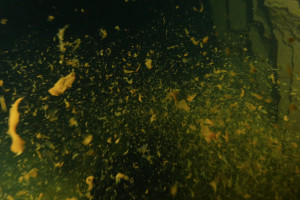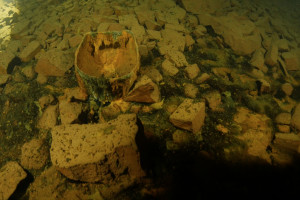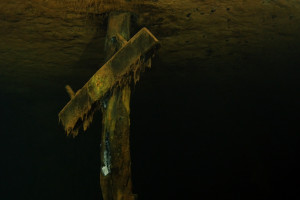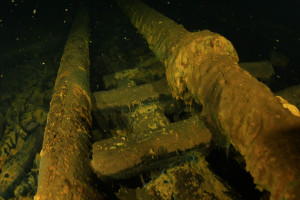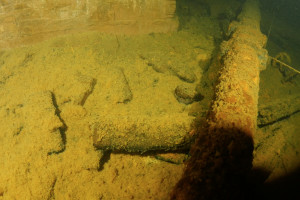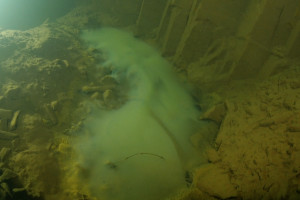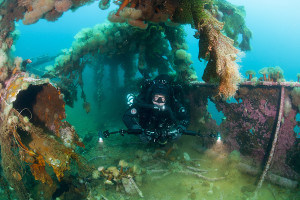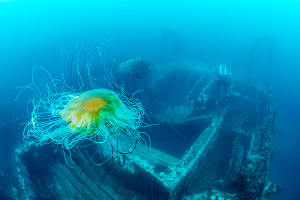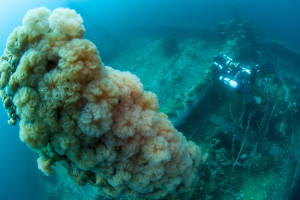Human Physiology
Making astronauts and scuba divers safer and decoding the mysteries of the human genome. The kind of science that’s taking place on the Mine Quest expedition is cutting edge and figuratively speaking, out of this world. Dr. Neal Pollock, research director for the Divers Alert Network and scientist at the Center for Environmental Physiology and Hyperbaric Medicine at Duke University Medical Center wants to close the gap between the theory and reality behind decompression sickness. He says that much of the information on decompression provided to divers and astronauts is based on theoretical modeling. While theory is important, human testing is incomplete, and theory does not include many variables that can affect individual risk.
His team will use ultrasound on Mine Quest divers to track the presence of microbubbles in their hearts—indicators of decompression stress. They will monitor the divers closely after each dive to determine if and when microbubbles appear and progress. They will also collect blood samples to assess other measures of decompression stress to compare with the bubble data. Studying divers in the field is important since “they’re diving profiles that are difficult to produce in the lab.” The Mine Quest team will provide an opportunity to study decompression stress over repeated days of repetitive, cold-water diving. The results will benefit divers and other who experience decompression stress, including astronauts who decompress to complete spacewalks.
The second experiment isn’t concerned so much with outer space, as it is inner space. Dr. Dawn Kernagis of the Institute for Human and Machine Cognition in Florida, will be looking at whether and how stress can actually re-program humans at a genetic level. They’re called epigenetic changes and science is only just starting to realize that such a change is possible. Prior to now the conventional wisdom was that our genetic code was fixed. Not so, according to Kernagis. She says a number of factors, including stress, can bring on changes to our very genetic make up. She’ll be having blood drawn from the divers before and after they dive that will enable her to look for micro particles that develop in response the stress. Based on the appearance of those markers Kernagis can conduct further work to see whether that results in a corresponding change at a genetic level. Her work could have enormous implications for such afflictions as childhood obesity and elder diabetes. Dr. Kernagis’ work is currently being partly supported by the U.S. government. – Robert Osborne
Biology of the Mine
I’ve worked with biologists in anchialine caves around the world. Anchialine caves contain both fresh and saltwater environments. They are biological hotspots, home to unique cave adapted species that reside all or part of their lives in the complete darkness. We find life in ancient caves but also very young ones. Global sea levels have fluctuated greatly over time leaving some caves alternately dry and wet over different epochs. Bell Island is a sort of an anchialine cave; a manmade one.
On a geologic time scale the Bell Island mine is as young as it gets. Other young caves are filled with very ancient animals. We don’t know where they came from. Do tiny creatures live within the matrix of the rock and migrate into larger spaces where we find them today? Will we find macro fauna in Bell Island Mine?
On my previous two visits this year, I observed interesting bacterial colonies residing in pols on the floor of the mine and draping over machinery perhaps oxidizing the iron. I’m just an artist with a a wild imagination, so we have contacted scientists who can help us DNA type biological materials found within the mine. These samples will be studied by Dr. Ann Cheeptham, and graduate students from the microbiology department of Thompson Rivers University, British Columbia.
We’ll keep you posted as we learn more.
Wrecks to Reefs
Today, divers can visit these remarkable war wrecks a short distance from shore. Experienced divers can plunge into the cold water and explore shipwrecks resplendent with colorful marine growth. Submerged wrecks become artificial reefs and when they are situated in rich waters like Conception Bay, Newfoundland, they become magnets for biodiversity.
Newfoundland’s Ecozone
Geography
Most of the ecozone is thousands of meters deep, although the Grand Banks of Newfoundland is quite shallow averaging 150 meters depth.
Plants
Tiny phytoplankton provide the basis for the food web. Giant kelp and seaweed are common, especially in intertidal zones.
Mammals
Harbour seal, grey seal, harbour porpoise, atlantic harbour porpoise, longsnout dolphin, orca, atlantic beaked whale, northern bottlenose whale, blue whale, fin whale, pilot whale, beluga, minke whale, blue whale, atlantic right whale, sperm whale, and humpback whale are found living in or migrating through the area.
Birds
Northern fulmar, greater shearwater, dovekie, common murre, thickbilled murre, Leach’s storm petrel, arctic tern, eider. Various kittiwakes, puffins, cormorants and gulls are common.
Fish
Atlantic tomcod, mummichog, redfish, herring, silver hake, Greenland halibut (turbot), and dangerously overfished northern cod. Sea lamprey, atlantic sturgeon, alewife, atlantic salmon and American eel live most of their lives in the ocean but enter freshwater to spawn.
Crustaceans
Stone crab, Neolithodes grimaldii, American lobster, rock crab, Lucifer faxoni, Sclerocrangon boreas, acadian hermit-crab, striped pink shrimp, Lebbeus groenlandicus, and Axius serratus.
Other Invertebrates
The large shallow areas of the ecozone provide habitat for barnacles, sea stars, sponges, clams, jellyfish, and other invertebrates.
Not a Diver?
If you are not a diver but still want to experience Newfoundland’s marine life up close, take a visit to the Petty Harbor Mini Aquarium. At Petty Harbor, marine life takes a vacation form the ocean to delight visitors for the summer season. After their sojourn, they are returned to the sea. Educational exhibits include touch tanks and eye-level aquariums for little people.
